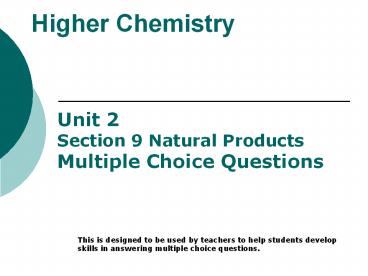Higher Chemistry - PowerPoint PPT Presentation
1 / 11
Title:
Higher Chemistry
Description:
Higher Chemistry Unit 2 Section 9 Natural Products Multiple Choice Questions This is designed to be used by teachers to help students develop skills in answering ... – PowerPoint PPT presentation
Number of Views:69
Avg rating:3.0/5.0
Title: Higher Chemistry
1
Higher Chemistry
Unit 2 Section 9 Natural Products Multiple Choice
Questions
This is designed to be used by teachers to help
students develop skills in answering multiple
choice questions.
2
Higher ChemistryUnit 2 - Section 9 Natural
ProductsMultiple Choice Questions
- 1. In the formation of hardened fats from
vegetable oils, the hydrogen - A. causes cross-linking between chains
- B. causes hydrolysis to occur
- C. increases the carbon chain length
- D. reduces the number of carbon- carbon double
bonds
D.
Answer
3
Higher ChemistryUnit 2 - Section 9 Natural
ProductsMultiple Choice Questions
- 2. Olestra is a calorie free fat made by reacting
fatty acids with sucrose. The structure of a
sucrose molecule can be represented as shown. - How many fatty acid molecules can react with one
molecule of sucrose? - A. 3 B. 5 C. 8 D. 11
C.
Answer
4
Higher ChemistryUnit 2 - Section 9 Natural
ProductsMultiple Choice Questions
- 3. Proteins can be denatured under acid
conditions. During this denaturing, the protein
molecule - A. changes shape
- B. is dehydrated
- C. is neutralised
- D. is polymerised
A.
Answer
5
Higher ChemistryUnit 2 - Section 9 Natural
ProductsMultiple Choice Questions
- 4. The production of fatty acids and glycerol
from fats in foods is an example of - A. hydrolysis
- B. hydrogenation
- C. dehydration
- D. dehydrogenation
A.
Answer
6
Higher ChemistryUnit 2 - Section 9 Natural
ProductsMultiple Choice Questions
- 5. When two amino acids condense together, water
is eliminated and a peptide link is formed. Which
of the following represents this process? - A.
- B.
- C.
- D.
A.
Answer
7
Higher ChemistryUnit 2 - Section 9 Natural
ProductsMultiple Choice Questions
- 6. Amino acids are converted into proteins by
- A. dehydration
- B. hydrogenation
- C. hydrolysis
- D. condensation
D.
Answer
8
Higher ChemistryUnit 2 - Section 9 Natural
ProductsMultiple Choice Questions
- 7. Fats and oils can be classified as
- A. carbohydrates
- B. acids
- C. esters
- D. alcohols
C.
Answer
9
Higher ChemistryUnit 2 - Section 9 Natural
ProductsMultiple Choice Questions
- 8. The breakdown of fats and oils produces
glycerol and fatty acids in the ratio of - A. one mole to two moles
- B. one mole to three moles
- C. one mole to four moles
- D. one mole to five moles
B.
Answer
10
Higher ChemistryUnit 2 - Section 9 Natural
ProductsMultiple Choice Questions
- 9. Fats have higher melting points than oils
because fats - A. have more hydrogen bonds
- B. have stronger van der Waals forces
- C. are more loosely packed
- D. are more unsaturated
B.
Answer
11
Higher ChemistryUnit 2 - Section 9 Natural
ProductsMultiple Choice Questions
- 10. Hormones and enzymes are
- A. fibrous proteins
- B. globular proteins
- C. fats
- D. oils
B.
Answer































